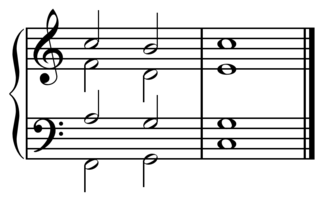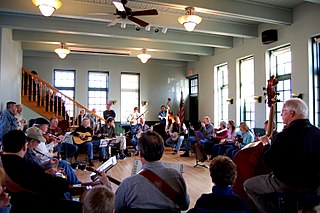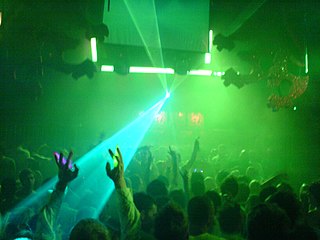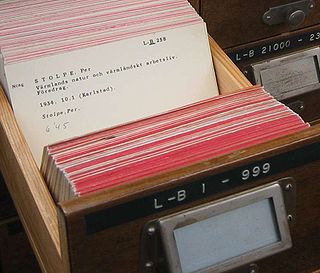
The term jazz guitar may refer to either a type of guitar or to the variety of guitar playing styles used in the various genres which are commonly termed "jazz". The jazz-type guitar was born as a result of using electric amplification to increase the volume of conventional acoustic guitars.
Modal jazz is jazz that uses musical modes rather than tonal scales and thinking as a framework. Although precedents exist, modal jazz was crystallized as a theory by composer George Russell in his 1953 book Lydian Chromatic Concept of Tonal Organization.
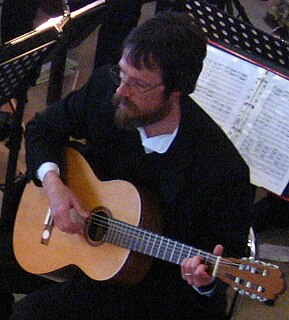
Accompaniment is the musical part which provides the rhythmic and/or harmonic support for the melody or main themes of a song or instrumental piece. There are many different styles and types of accompaniment in different genres and styles of music. In homophonic music, the main accompaniment approach used in popular music, a clear vocal melody is supported by subordinate chords. In popular music and traditional music, the accompaniment parts typically provide the "beat" for the music and outline the chord progression of the song or instrumental piece.
The Real Book can refer to any of a number of popular compilations of lead sheets for jazz tunes. It usually refers to Volume 1 of an underground series of books transcribed and collated by students at Berklee College of Music during the 1970s.
Comping is the chords, rhythms, and countermelodies that keyboard players, guitar players, or drummers use to support a jazz musician's improvised solo or melody lines. It is also the action of accompanying, and the left-hand part of a solo pianist.
A rhythm section is a group of musicians within a music ensemble or band who provide the underlying rhythm, harmony and pulse of the accompaniment, providing a rhythmic and harmonic reference and "beat" for the rest of the band.
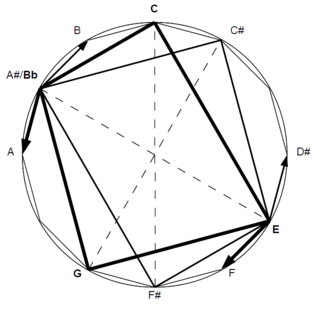
In music theory, chord substitution is the technique of using a chord in place of another in a sequence of chords, or a chord progression. Much of the European classical repertoire and the vast majority of blues, jazz and rock music songs are based on chord progressions. "A chord substitution occurs when a chord is replaced by another that is made to function like the original. Usually substituted chords possess two pitches in common with the triad that they are replacing."

Jazz piano is a collective term for the techniques pianists use when playing jazz. The piano has been an integral part of the jazz idiom since its inception, in both solo and ensemble settings. Its role is multifaceted due largely to the instrument's combined melodic and harmonic capabilities. For this reason it is an important tool of jazz musicians and composers for teaching and learning jazz theory and set arrangement, regardless of their main instrument.
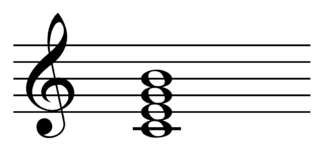
Jazz chords refer to chords, chord voicings and chord symbols that jazz musicians commonly use in composition, improvisation, and harmony. In jazz chords and theory, most triads that appear in lead sheets or fake books can have sevenths added to them, using the performer's discretion and ear. For example, if a tune is in the key of C, if there is a G chord, the chord-playing performer usually "voices" this chord as G7. While in a strict classical music context, the notes of a G7 chord would be G–B–D–F, jazz often omits the fifth of the chord—and even the root if playing in a group. However, not all jazz pianists leave out the root when they play voicings: Bud Powell, one of the best-known of the bebop pianists, and Horace Silver, whose quintet included many of jazz's biggest names from the 1950s to the 1970s, included the root note in their voicings.
In its broadest sense, the head of a piece of music is its main theme, particularly in jazz, where the term takes on a more specific set of connotations. In other types of music, "head" may refer to the first or most prominent section of a song. The term may, though obtusely, be applied to classical music, insofar as classical pieces generally bear similar thematic elements, but the preferred term in this instance is (main) theme or subject. The term "head" is most often used in jazz and may refer to the thematic melody, an instance of it in a performance of the song, or a more abstract compilation of ideas as to what the song is. It may also, though uncommonly, refer to the first section of the melody, or the theme riff in the melody.
In jazz and jazz harmony, "rhythm changes" refers to the 32 bar chord progression occurring in George Gershwin's song "I Got Rhythm." The progression uses an AABA form, with each A section based on repetitions of the ubiquitous I-vi-ii-V sequence, and the B section using a circle of fourths sequence based on iii7-vi7-ii7-V7, a progression which is sometimes given passing chords. This pattern, "one of the most common vehicles for improvisation," forms the basis of countless jazz compositions and was popular with swing-era and Bebop musicians. It is found in "Shoeshine Boy" and "Cotton Tail" written by Duke Ellington in 1940, as well as Charlie Christian's "Seven Come Eleven," Dizzy Gillespie's "Salt Peanuts," and Thelonious Monk's "Rhythm-a-Ning," for instance. The earliest known use of rhythm changes was by Sidney Bechet in his September 15, 1932 recording of "Shag" with his "New Orleans Feetwarmers" group.
Wilton Jameson "Jamey" Aebersold is an American publisher, educator, and jazz saxophonist. His Play-A-Long series of instructional books and CDs, using the chord-scale system, the first of which was released in 1967, are an internationally renowned resource for jazz education. His summer workshops have educated students of all ages since the 1960s.

A chord chart is a form of musical notation that describes the basic harmonic and rhythmic information for a song or tune. It is the most common form of notation used by professional session musicians playing jazz or popular music. It is intended primarily for a rhythm section. In these genres the musicians are expected to be able to improvise the individual notes used for the chords and the appropriate ornamentation, counter melody or bassline.
Jazz improvisation is the spontaneous invention of melodic solo lines or accompaniment parts. It is one of the defining elements of jazz. Improvisation is composing on the spot, when a singer or instrumentalist invents melodies and lines over a chord progression played by rhythm section instruments and accompanied by drums. Although blues, rock, and other genres use improvisation, it is done over relatively simple chord progressions which often remain in one key.
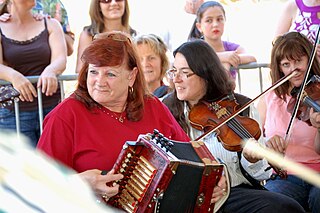
A music session is a social gathering of musicians and singers who perform music in a relatively informal context. Much of the music performed at such events is traditional music for the area, popular songs and other well-known tunes. In sessions, the participants typically improvise the accompaniment, song arrangements and musical ornaments to the melodies of songs or tunes. The venue may be a public bar, tavern, village hall or a private home.
This is a list of jazz and popular music terms that are likely to be encountered in printed popular music songbooks, fake books and vocal scores, big band scores, jazz, and rock concert reviews, and album liner notes. This glossary includes terms for musical instruments, playing or singing techniques, amplifiers, effects units, sound reinforcement equipment, and recording gear and techniques which are widely used in jazz and popular music. Most of the terms are in English, but in some cases, terms from other languages are encountered.
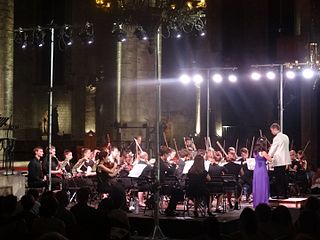
In instrumental music performances in Western classical music, "faking" is the process by which a musician gives the "...impression of playing every note as written" in the printed music part, typically for a very challenging passage that is very high in pitch and/or very rapid, while not actually playing all of the notes in the part. Faking may be done by an orchestra musician, a concerto soloist or a chamber musician; however, faking tends to be more associated with orchestra playing, because the presence of such a large music ensemble makes it easier for musicians who "fake" to do so without being detected. A concerto soloist or chamber musician who faked passages would be much easier for audience members and other musicians to detect. Orchestra musicians at every level, from amateur orchestras and youth orchestras to professional orchestra players will occasionally "fake" a hard passage.
In jazz, the term "faking" means to improvise accompaniment parts. The term "faking" in jazz does not have the same meaning as in faking in Classical music, where faking is seen as a controversial activity. In jazz, when a jazz quartet "fakes" accompaniment parts to a song with a singer, this is a synonym for improvising their backup parts. Improvising backup lines is an essential skill for jazz musicians. The use of the term "fake" in the jazz scene is illustrated by the expression "fake book", a collection of lead sheets and chord progressions for jazz standards. The reason the book is called a "fake book" is because trained jazz performers are able to improvise accompaniment parts and solos from the chord charts contained therein.



